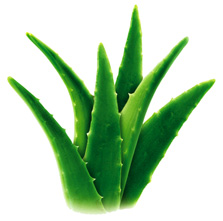|
Description of the inner central part of the aloe leaf may sometimes be confusing, due to the different terms that are used interchangeably such as inner pulp, mucilage tissue, mucilaginous gel, mucilaginous jelly, inner gel and leaf parenchyma tissue.
Technically, the term 'pulp' or 'parenchyma tissue' refers to the intact fleshy inner part of the leaf including the cell walls and organelles, while 'gel' or 'mucilage' refers to the viscous clear liquid within the parenchyma cells.
|

|
The three structural components of the Aloe Vera pulp are the cell walls, the degenerated organelles and the viscous liquid contained within the cells. The raw pulp of Aloe Vera contains approximately 98.5% water, while the mucilage or gel consists of about 99.5% water.
The remaining 0.5 – 1% solid material consists of a range of compounds including water-soluble and fat-soluble vitamins, minerals, enzymes, polysaccharides, phenolic compounds and organic acids.
|